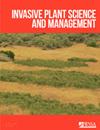Improving chemical control of nonnative aquatic plants in run-of-the-river reservoirs
IF 1.2
4区 生物学
Q3 PLANT SCIENCES
引用次数: 0
Abstract
Abstract Current dam discharge patterns in Noxon Rapids Reservoir reduce concentration and exposure times (CET) of herbicides used for aquatic plant management. Herbicide applications during periods of low dam discharge may increase herbicide CETs and improve efficacy. Applications of rhodamine WT dye were monitored under peak (736 to 765 m3 s–1) and minimum (1.4 to 2.8 m3 s–1) dam discharge patterns to quantify water-exchange processes. Whole-plot dye half-life under minimal discharge was 33 h, a 15-fold increase compared with the dye treatment during peak discharge. Triclopyr concentrations measured during minimum discharge within the treated plot ranged from 214 ± 25 to 1,243 ± 36 µg L–1 from 0 to 48 h after treatment (HAT), respectively. Endothall concentrations measured during minimum discharge in the same plot ranged from 164 ± 78 to 2,195 ± 1,043 µg L–1 from 0 to 48 HAT, respectively. Eurasian watermilfoil (Myriophyllum spicatum L.) occurrence in the treatment plot was 66%, 8%, and 14% during pretreatment, 5 wk after treatment (WAT), and 52 WAT, respectively. Myriophyllum spicatum occurrence in the nontreated plot was 68%, 71%, and 83% during pretreatment, 5 WAT, and 52 WAT, respectively. Curlyleaf pondweed (Potamogeton crispus L.) occurrence in the treatment plot was 29%, 0%, and 97% during pretreatment, 5 WAT, and 52 WAT, respectively. Potamogeton crispus increased from 24% to 83% at 0 WAT to 52 WAT, respectively, in the nontreated plot. Native species richness declined from 3.3 species per point to 2.1 in the treatment plot in the year of treatment but returned to pretreatment numbers by 52 WAT. Native species richness did not change during the study in the nontreated reference plot. Herbicide applications during periods of low flow can increase CETs and improve control, whereas applications during times of high-water flow would shorten CETs and could result in reduced treatment efficacy.加强对径流式水库外来水生植物的化学防治
摘要Noxon Rapids水库目前的大坝排放模式降低了用于水生植物管理的除草剂的浓度和暴露时间(CET)。在枯水期施用除草剂可能会增加除草剂的CET并提高药效。罗丹明WT染料的应用在峰值(736至765 m3 s–1)和最小(1.4至2.8 m3 s–2)坝流量模式下进行监测,以量化水交换过程。最小放电条件下的全图染料半衰期为33小时,与峰值放电期间的染料处理相比增加了15倍。在处理后0至48小时(HAT),处理区内最小排放期间测得的三氯吡浓度范围分别为214±25至1243±36µg L-1。在同一图中,最小放电期间测得的内皮素浓度范围分别为164±78至2195±1043µg L–1(0至48 HAT)。在处理区,处理前、处理后5周(WAT)和处理后52周,欧亚水翼(Myriophyllum spicatum L.)的发生率分别为66%、8%和14%。在预处理过程中,未处理小区中五香麦穗的发生率分别为68%、71%和83%,分别为5和52。在预处理期间,处理小区中的卷叶pondweed(Potamogeton crispus L.)发生率分别为29%、0%和97%,分别为5WAT和52WAT。在未处理的小区中,0瓦特至52瓦特时,脆土豆从24%分别增加到83%。在处理当年,处理区的本地物种丰富度从每点3.3种下降到2.1种,但在52瓦特时又恢复到了处理前的数量。在未处理的参考地块中,本地物种丰富度在研究期间没有变化。在低流量时期施用除草剂可以增加CET并改善控制,而在高流量时期施用会缩短CET并可能导致治疗效果降低。
本文章由计算机程序翻译,如有差异,请以英文原文为准。
求助全文
约1分钟内获得全文
求助全文
来源期刊

Invasive Plant Science and Management
PLANT SCIENCES-
CiteScore
2.20
自引率
9.10%
发文量
24
审稿时长
6-12 weeks
期刊介绍:
Invasive Plant Science and Management (IPSM) is an online peer-reviewed journal focusing on fundamental and applied research on invasive plant biology, ecology, management, and restoration of invaded non-crop areas, and on other aspects relevant to invasive species, including educational activities and policy issues. Topics include the biology and ecology of invasive plants in rangeland, prairie, pasture, wildland, forestry, riparian, wetland, aquatic, recreational, rights-of-ways, and other non-crop (parks, preserves, natural areas) settings; genetics of invasive plants; social, ecological, and economic impacts of invasive plants and their management; design, efficacy, and integration of control tools; land restoration and rehabilitation; effects of management on soil, air, water, and wildlife; education, extension, and outreach methods and resources; technology and product reports; mapping and remote sensing, inventory and monitoring; technology transfer tools; case study reports; and regulatory issues.
 求助内容:
求助内容: 应助结果提醒方式:
应助结果提醒方式:


